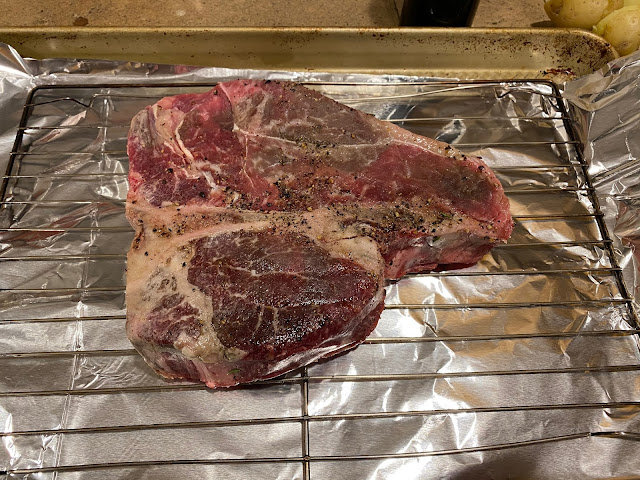We used the reverse-sear technique because it eliminates some of the guesswork that comes with other cooking methods. “Instead of searing and cooking, you get it to temperature and just sear it to finish.”
To start, you’ll want to put a wire grate in a decent-sized pan and then load your steak into it — after seasoning of course.
“Season the hell out of that thing”. “I’m a salt and pepper guy. I’ve also heard people talk about don’t put pepper on it because it gets bitter. Use a grainier salt. Table salt’s also fine. Just buy a box of kosher salt, it’s inexpensive.”
Once that’s done, it’s time to head for the oven.
“The idea is to slow roast the Steak. You can do it as low as like 200 or 225 degrees, but I find that tries my patience,” Yasuda says. “Two-hundred or 275 is probably better and it doesn’t overcook it, but you’re going to let that thing slow roast, especially with a big steak. We’re going to have to get that steak’s internal temperature up to 128. For a thick steak, it’s going to probably be an hour or maybe a little less.”
For best results when checking the steak’s temperature, Yasuda suggests using a digital thermometer.
“I always start checking, no matter what, at like at half an hour, just to be sure,” Yasuda says. “Then, when it gets to the 128, degrees you pull it out. It’s kind of nice because at that point it can kind of just hang out. If I was having people coming over and they were late, I’m not going to sweat it at all. It’s not critical to let the steak rest at that stage. When it’s time to reverse it, get your carbon steel or my cast-iron pan prepped with grapeseed oil and crank things as high as they’ll go. Then, you sear it on both sides for 60-90 seconds. This time it’s nice because you don’t want to do it too much because you’ll see it start cooking inside if you leave it on there too long. After searing, it has that crust. Like when you slice that with your knife, it takes a minute to bite through and then it goes … I’m kind of salivating thinking about it.”
After cleaning up your drool, there’s just one more thing to do.
“Pull it out of the skillet, put it on your cutting board and let it rest for 10 minutes. That resting is huge,” Yasuda says. “If you cut a steak rare like that, the juice just flows out like crazy. Let it rest, and juice aside, it’s going to continue cooking. I think resting is the secret sauce, as long as it’s the right temperature. You don’t want to eat anything when it’s super hot because you don’t really taste it. Resting allows the meat to firm up and the juices to come back in. Steak is pretty simple. Don’t mess with it too much.”




No comments:
Post a Comment